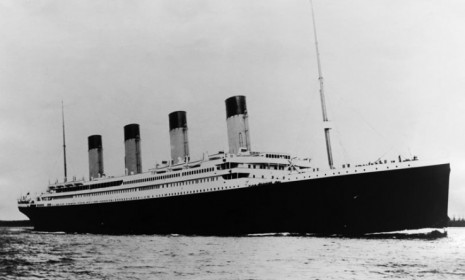Did a rare 'supermoon' sink the Titanic?
Astronomers say that a unique combination of celestial forces may have dislodged the icebergs that clogged the cruise liner's path

A century has passed since the Titanic sank, killing 1,500 passengers and crew members. But a pair of Texas State University astronomers, Olson David and Russell Descher, have a brand new theory on what set the tragedy in motion. They say a rare lunar event may have put the ship on its catastrophic collision course with an iceberg. Here's how a once-in-a-lifetime "supermoon" may have spelled doom for the most famous maiden voyage in history:
What's a supermoon?
It's a term used to describe a full (or new) moon that occurs when the moon is making its closest approach to Earth, says Natalie Wolchover at LiveScience. A "supermoon" appears much bigger and brighter in the night sky than an ordinary moon. Due to its proximity to Earth, it also exerts a greater gravitational pull, magnifying the moon's effect on ocean tides.
The Week
Escape your echo chamber. Get the facts behind the news, plus analysis from multiple perspectives.

Sign up for The Week's Free Newsletters
From our morning news briefing to a weekly Good News Newsletter, get the best of The Week delivered directly to your inbox.
From our morning news briefing to a weekly Good News Newsletter, get the best of The Week delivered directly to your inbox.
How did a supermoon do in the Titanic?
On Jan. 4, 1912, the most extreme supermoon in 1,400 years may have caused extreme tidal activity that dislodged icebergs from a glacier in Greenland. In Sky & Telescope magazine, astronomers David and Descher argue that this rare supermoon also coincided with the Earth's perihelion, or the point when the planet is closest to the sun. "Together, these events caused extreme tides that could have dislodged icebergs and flung them into southbound ocean currents," says Wolchover.
And these icebergs got into the boat's path?
According to the calculations of the astronomers, yes. The "once-in-a-lifetime swell" would have swept the icebergs even farther south than normal, says Nick Collins at the U.K.'s Telegraph. It would have taken the icebergs exactly three months to be carried by the Atlantic Ocean's currents into the shipping lanes. The Titanic's ill-fated crash happened on April 14th of that year.
A free daily email with the biggest news stories of the day – and the best features from TheWeek.com
How realistic is this scenerio?
It's very plausible, and it helps explain the unusual abundance of icebergs in the Atlantic in the spring of 1912, says study co-author David Olson. "Of course, the ultimate cause of the accident was that the ship struck an iceberg. The Titanic failed to slow down, even after having received several wireless messages warning of ice ahead." The crew instead chose to charge ahead at full speed — and the rest is history.
Sources: Daily Mail, LiveScience, Reuters, Telegraph

